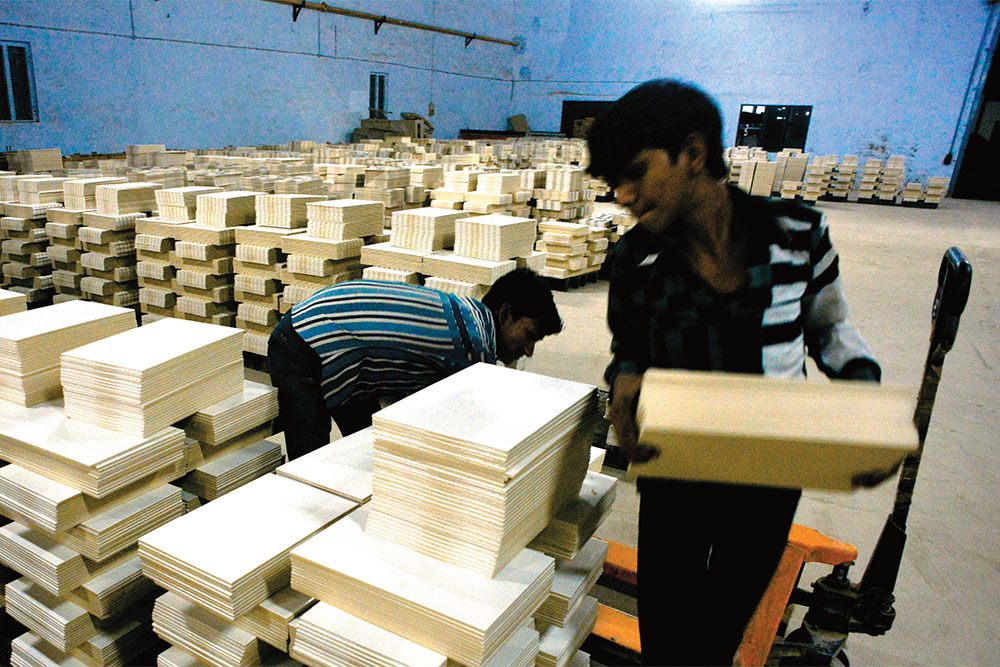Driving down National Highway 8A from Ahmedabad to Morbi, even in the sweltering heat, can be a pleasure. The asphalt road doesn’t have a single pothole or bump. Along the way, factories belch out voluminous amounts of smoke and 18-wheeler trucks ferry raw materials to them. What is jarring, however, is the absence of real-estate hoardings — speaking of a lull that mars the business of tile makers in Morbi, whose fortunes are tied to the housing industry.
In 1926, Parshuram Kanpule from Maharashtra migrated to Morbi and set up its first roofing tiles unit, following it up with a stoneware pipe unit, sanitaryware unit, glazed tile unit and refractories, among others, under the name Parshuram Potteries, thus putting Morbi on the industrial map. Soon after, farmers from the Patel community, suffering due to inadequate rainfall, set up similar units in the Morbi-Wankaner district.
Morbi is now India’s largest ceramic tile-making cluster, spread over an area of 60 sq km with 390 glazed-tile units, having an annual production capacity of 854 million sq m of tiles, 65 sanitaryware units with an annual production capacity of 28.5 million pieces and 150 floor tile and vitrified tile units, that boast of an annual production capacity of 383 million sq m of tiles. Ninety per cent of India’s tiles are supplied by Morbi and the region is also a top export supplier, having hegemony in exports to Africa and the Gulf Cooperation Council (GCC) region.
Given that the cluster is heavily dependent on the real-estate market, the lull in the housing market has reduced the domestic demand for most tile makers. As a result, FY15 has seen excess capacity and piling up of inventory, and for many companies, capex plans have been put on hold.
To add to that, there has been a glut of cheap imports from China in the past three months. Most tile manufacturers in Morbi are coping by focusing on exports. As we pull into our first meeting, we are greeted by 32-year-old Bhavesh Ambani, director of the Ambani Group of Companies, which has 50 tile companies under its banner and a combined turnover of ₹1,000 crore.
While business seems to be chugging along at a decent clip — with 20% growth in turnover every year for the past three years and net profit at 5% of turnover — Ambani bemoans the lack of infrastructure in the region.
“There is virtually no infrastructure here. Entrepreneurs have to pool in to make interior roads. Water, too, is a huge issue as we get a negligible supply. So, we have put borewells to get groundwater to meet our needs,” he says. But on a positive note, he adds, “Electricity supply from the government is excellent, as is the supply of gas.”
Greener pastures
Till December 2013, 80% of Morbi’s tile manufacturers were using coal gas as the chief fuel in the manufacturing process. This led to a lot of pollution but there was hardly any implementation of pollution-control norms by either the manufacturers or the Pollution Control Board (PCB).
Then, in December 2013, a litigation was filed to highlight this, leading to a regulation that industries in Morbi could continue using coal gas so long as they achieved 0% pollution. In subsequent negotiations between the PCB and industry captains like Ambani, this was changed to 10% emissions, and this was achieved by incorporating the latest pollution-control technology in plants.
To maintain cost efficiency, most companies switched to natural gas. However, natural gas is proving costly for companies as the government, which is supposed to sell it at the same rate at which it is procured, charges a higher rate. Typically, natural gas is 40% more expensive than coal gas.
“Despite intense lobbying, the government hasn’t given a clear go-ahead to use coal gas, nor brought down the price of natural gas,” complains Ambani. He adds that taxation is as steep as 35-40%, and there is poor connectivity between Morbi and the outside world, with only a biweekly flight to Delhi from Rajkot. Five years ago, permission was given for an airport in Morbi but there has been no development since.
“There is little to no government support and schemes designed to aid us exist only on paper,” he adds. As for land, while it is readily available, it costs a lot. Another chronic problem is the default on payments from customers, with ₹2,000 crore unpaid dues owed to the ceramic cluster in Morbi. However, the one positive is that access to funding from banks is readily available, as out of 600 tile units, only two have defaulted on loans.
Ambani, whose group is present in virtually every tile category ranging from glazed wall tiles and vitrified tiles to sanitaryware, has a total production capacity of 3.5 lakh boxes of tiles a day. The company soon plans to add four more factories. On occasion, when huge export orders loom and production is inadequate, it is outsourced to external parties to meet demand. But how does a SME group in hinterland Gujarat compete with bigwigs such as Cera and Kajaria Ceramics?
“Today, the average consumer is not buying these brands. Only big builders and other corporates are buying their stuff. In fact, a number of these bigger brands are bleeding and we were giving them tough competition. So now, many of them have tied up with units in Morbi in JVs, where we do the production and they do the marketing,” reveals Ambani. He blames the faltering domestic demand on the entry of new companies into the ceramic space every year. But Ambani does see some hope in the PM’s Swachh Bharat Abhiyan and Housing for All schemes, which he believes will act as catalysts for demand.
While Ambani remains optimistic, his counterpart at Welcome Tiles, who bemoans the oversupply situation. “Over the past three years, 120 wall-tile companies have entered the cluster. The domestic market is in the midst of a slump due to a slowdown in real estate, and this has hurt us really badly. To counter this, units are focusing more on exports, but here, too, we can’t compete with China, as our raw material and labour costs are higher so our products tend to be priced higher. Further, domestic products attract 36% excise duty and 15% VAT, making the whole exercise an unviable proposition,” says Nilesh Saradava, director of Welcome Tiles, where around 30% of wall tiles are exported and the rest are sold domestically.
He, too, echoes Ambani’s sentiments about the lack of proper infrastructure. “Every day, we have 50-70 businessmen and partners coming to Morbi. There is no proper connectivity for them to travel, nor are there good hotels for their stay. The less said about the water supply and the quality of interior roads, the better. In fact, half of Guntur road has been made by a couple of firms acting in collaboration,” says Saradava. His experience with electricity is markedly different from that of the others we met. “We experience power cuts everyday, sometimes thrice a day, so I have been forced to use generators,” he says.
Saradava says that while finance is easily available, the rate of interest, at 13.5%, is too high. He also points out that the rebate to be given by the government hasn’t been received by most firms in two years. “The biggest issue in Morbi is that of the C Form. Whenever we do a sale out of Gujarat, the customer has to pay tax and send us a form called the C Form. Often, they use fraudulent forms to evade tax, and when we file the forms we have to pay an 18% penalty. Implementation of GST will solve this,” he says.
The other problem he notes is the dumping of a vitrified tile product called double charge by China at cheaper rates, which has been flooding the Indian market for the three months now. Most manufacturers in Morbi are clamouring for an anti-dumping duty on China, and Saradava is no exception. Without it, the vitrified tile manufacturers seem to be staring at a bleak future. Yet another issue is the shortage of skilled labourers. Though there is an ITI in the region, it does not meet the demands of the industry. Labourers graduate after five years, during which the technology changes, rendering their training obsolete.
Ahead in style
The one thing that sets the Morbi cluster apart from its rivals in China and Italy, another tile-producing powerhouse, is the focus on R&D. Virtually every manufacturer has a lead over his Chinese and Italian counterparts in design, style and variety. Every company has to upgrade its technology for manufacturing every five years, or it gets left behind. Of course, this involves considerable expenditure and tends to dent margins.
Of late, a new technology called digital printing, in which data and images are printed directly from a computer and used for printing images on tiles, has revolutionised the industry in Morbi too. Saradava has installed digital machines in his unit and is banking on this new product for further traction.
Interestingly, Rajesh Shirvi, co-founder, Simola Vitrified Tiles, has a very positive view of Morbi’s competence. “The cluster can compete with China effectively. In some places, Chinese tiles are banned and in some others people are not happy with their quality. In terms of quality, design, and service, we are more competent,” he says. “I have no complaints about gas supply, water, roads, power supply, availability of land, credit from banks or government support. If an entrepreneur wants to set up a new unit, he gets an electricity connection in two months from GSEB,” he declares.
The lack of government subsidy, too, doesn’t perturb Shirvi much, and, echoing Saradava and Ambani, the only items on his wishlist are export benefits and the anti-dumping duty. For him, the other irritant is the rising cost of acquiring new land, which today constitutes 25% of the total investment in setting up a new plant. Shirvi and his ilk want a subsidised land parcel in a new distant location as well as more technical training institutes for staff.
Currently, most SMEs in Morbi are exporting at lower margin to make up for slack domestic demand. Simola exports 55% of its production, chiefly to Africa and the GCC, and is also making inroads into Turkey, North America, Germany and Brazil. To counter currency fluctuations, the company does forward bookings, in line with what most export-oriented units in Morbi are doing.
The company, which makes wall, floor and heavy-duty tiles, has a ₹75 crore turnover and makes a net margin of 3-5%, with a production capacity of 7,500 sq m of tiles per day. Over the last three years, it has grown at 10% in terms of sales, but Shirvi is reluctant to provide any forward guidance, citing continuous investment in technology upgradation, which scuttles growth projections.
Summing up the situation in Morbi, Nilesh Jetpariya, president of Morbi-Dhuva Glaze Tiles Association, says increased production by all tile manufacturers and reduced exports are to blame for the current mess. Jetpariya bemoans the fact that while MNCs get speedier approvals, for local entrepreneurs, there is no single-window clearance system and he, too, wants the introduction of GST. “If the government adequately markets our tile industry on international platforms, it will give us a huge boost.
There have been two dark periods in the history of Morbi. The first and the most worst was the 1979 Machhu Dam dam tragedy that wiped out the entire town. And the second instance was the 23-day strike in late 2013 that brought the entire cluster to a standstill as tile manufacturers showed their angst over government apathy. On both occasions, the town sprung back to life. This time around, business conditions are not conducive enough, but the cluster is living on hopes that achche din is just round the corner.












 Just one email a week
Just one email a week